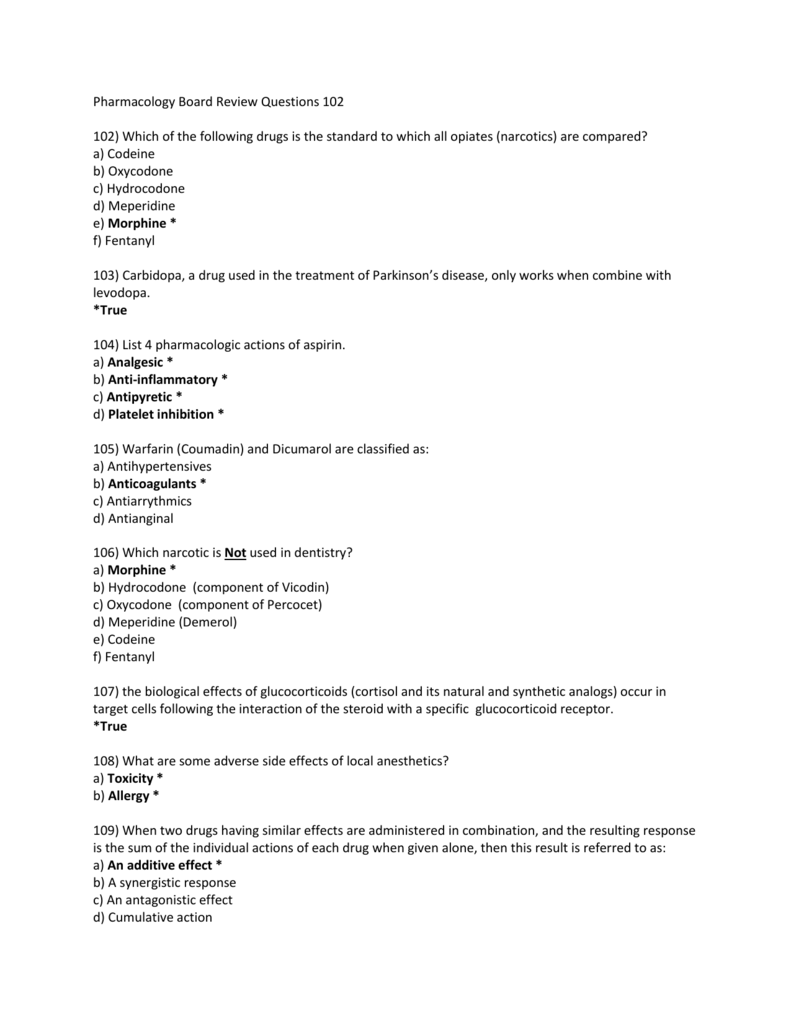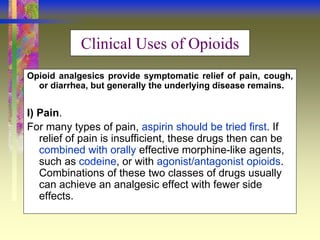Dihydrocodeine acetaminophen aspirin caffeine combination products. Opioid analgesics are used primarily for the treatment of moderate to severe acute pain and chronic pain and in the treatment and management of opiate dependence.

Pdf Opioid Analgesics A 2018 Update
Opioid analgesics are used for the following.

. The authors studied opioid prescriptions among 296452 adults older than 18 years who underwent carpal tunnel release trigger finger release cubital tunnel release or thumb carpometacarpal arthroplasty from 2009 to 2013 using insurance claims drawn from the Truven Health MarketScan Commercial Claims and Encounters which encompasses over 100 health. Narcotic agents are potent analgesics which are effective for the relief of severe pain. Narcotics Narcotics 4 -act on the Central Nervous System -block the transmission of pain signals -used for moderate to severe pain -Stongest Analgesics Narcotic examples 5 -morphine -meperdine -codeine -oxycodone -hydrocodone Tylenol 1 contains 8mg of codeine Tylenol 2 contains 15mg of codeine Tylenol 3 contains 30mg of codeine Percocet.
Uce initial opioid prescribing to a 3-day supply for most acute pain incidents. With each opioid prescription a patients risk for opioid. A Severe acute pain.
Including glucuronide conjugates of opioid analgesics are excreted mainly in the. 2 It may be appropriate to prescribe aspirin in addition to a narcotic especially in patients with bonepain. Post-synaptic inhibition by endorphins is caused by.
B Mild acute pain. The advent of new agents has been accompanied by increased prescription of narcotic analgesics NA in industrialized nations raising concerns about potential abuse 9-11. We aimed to evaluate the extent of leftover opioid analgesics following pediatric ambulatory surgeries in the context of a state-mandated restrictive opioid-prescribing policy.
There are several alternative strong opioids available for example morphine oxycodone hydromorphone and fentanyl each with comparable efficacy at a population level. Analgesics reduce or abolish pain without causing impairment of consciousness mental confusion incoordination or paralysis or some other disturbances of nervous system. The term analgesic means without pain.
We also aimed to evaluate opioid disposal rates methods of disposal and reasons for nondisposal. Analgesics are selective central nervous system depressants used to relieve pain. Patient present with impaired renal function presents for surgery and is administered a preoperative opioid to help with his anxiety.
All of the following are synthetic opiate drugs EXCEPT. Opiate drugs used medically are usually administered. Intravenous formulations of opioids such as morphine hydromorphone and fentanyl very frequently are used to provide analgesia and supplement sedation in an inpatient setting particularly in the perioperative setting.
3 It is logical to combine analgesics that act via different mechanisms for example. Worldwide about 500 000 deaths are attributable to drug use. Pharmaceutical morphine is used as a narcotic analgesic for both acute and chronic pain management and also to provide sedation before surgical procedures.
Codeine Acetaminophen Aspirin Butalbital Combination Products. Tylenol with Codeine 2 Tylenol with Codeine 3 Tylenol with Codeine 4. Uce initial opioid prescribing to a 3-day supply for most acute pain incidents.
Select all that apply. Fentanyl also exists formulated for transdermal patches for extended absorption. Background Everyday people die unnecessarily from opioid overdose-related addiction.
People living in a region where iodine - 131 was known to have been deposited were encouraged to use table salt enriched with a non-radioactive isotope of iodine. Ibuprofen CD A О B oc. Cogesic Fioricet Fiorinal with Codeine Ascomp.
Opioid-seeking behaviors have been linked to receipt of initial opioid prescriptions following the common dental procedure of third molar extraction. Sufentanyl А 00 Ос D Question 16 5 pts which one of the following non-narcotic agent inhibits mainly cyclooxgenase cox in CNS. An opioid overdose can be identified by a combination of three signs and symptoms.
Thefollowing points should be noted. Question 9 5 pts which of the following opioid analgesics is a partial mu receptor agonist A Morphine B. 40 At an individual level however there is wide variation in opioid analgesic efficacy and side effects the reasons for which are not fully understood but may in part be genetic.
Acute pulmonary edema 3. Even in therapeutic doses narcotic analgesics can cause respiratory depression nausea and drowsiness. Opioid use can lead to death due to the effects of opioids on the part of the brain which regulates breathing.
Opioid antagonists remain the standard treatment for respiratory depression following opioid overdose with naloxone being by far the most commonly used although the longer acting antagonist nalmefene may be used for treating overdoses of long-acting opioids such as methadone and diprenorphine is used for reversing the effects of extremely potent opioids. All of the following are naturally occurring opiates EXCEPT. While numerous pharmacologic and non-pharmacologic treatments for pain exist opioid analgesics remain important options for relieving pain.
We aimed to evaluate the extent of leftover opioid analgesics following pediatric ambulatory surgeries in the context of a state-mandated restrictive opioid-prescribing policy. Thus they elicit an indirect performance enhancement effect by improving the athletes morale. To test if the non-opioid analgesics are non-inferior to opioid analgesics for pain management hypothesis 1a we chose a small and clinically non-significant difference d 10 as the non-inferiority margin and assumed the maximum standard deviation SD of the daily pain intensity to be 36 based on data from prior studies 42 79 80.
1 Withmildormoderatepain useanon-narcoticin the first instance. D Mild chronic pain. Narcotic Analgesics Relieves moderate to severe pain also a cough suppressant Antitussives and to stop severe diarrhea.
Morphine continues to be one of the most widely utilized pain medications in hospital settings where it was once administered almost entirely as an injectable solution. We also aimed to evaluate opioid disposal rates methods of disposal and reasons for nondisposal. The Opioid Analgesic REMS approved on September 18 2018 is one strategy among multiple national and state efforts to reduce the risk of abuse misuse addiction overdose and deaths due to.
Read the following short-up and give the answer to the given question. Bind to specific receptors within the brain and depress certain parts of the CNS to cause pain relief respiratory depression decreased GI. Furthermore given their mood-altering properties narcotic analgesics can be used to alleviate negative emotions psychological stress and performance anxiety.
All of the following are effects of narcotic analgesics EXCEPT. C Moderate chronic pain. Dentists are among the leading prescribers of opioid analgesics.
Heroin is converted to ___ in the brain. Some time later he has a seizure.


0 Comments